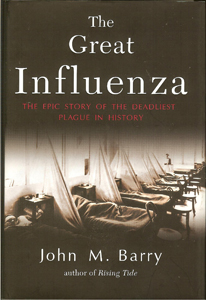 John M. Barry, The Great Influenza: The Story of the Deadliest Pandemic in History (New York: Viking, 2004), 546pp.
John M. Barry, The Great Influenza: The Story of the Deadliest Pandemic in History (New York: Viking, 2004), 546pp.
A review by Brad Keister, former Deputy Division Director of the Physics Division for the National Science Foundation.
This book tells the horrifying story of a particular strain of influenza that swept the globe near the end of the First World War, those who suffered and died from it, as well as those people in positions of power who altered its course: the physicians, the scientists, and the politicians.
As Barry observes, there had been other strains of influenza in the past, but this one, now known as H1N1, was particularly virulent, causing pain and death, sometimes within hours. The precise origin cannot be traced, but it appears to have started at a military base in Kansas in late 1918, while the United States was immersed in World War I. The wartime setting meant that bases were often crowded or overcrowded, and soldiers were often quickly moved from one base to another. It also meant that, as the disease spread, there was a conscious attempt to downplay its effect in order to avoid a demoralizing impact on the war effort.
But it wasn't long before soldiers carried the virus to cities, with devastating results. The mortality rate in some cities rose to the point where the dead could not be buried fast enough—reminiscent of the Bubonic Plague in the 14th century. Some politicians ignored the crisis, chose not to learn about the disease, and eventually became irrelevant, as other individuals from the private and public sectors eventually stepped in. American society was inundated with rumors and tales about how to combat the illness, making it difficult to filter what true information there was.
Compounding the tragedy was the fact that medicine as we know it now was almost non-existent a mere hundred years ago. Barry provides a historical background, noting that, as recently as the late nineteenth century, medical schools were simply money-making operations, admitting anyone willing to pay, college degree or no, thus perpetuating a culture of gross incompetence. That began to change with the founding of Johns Hopkins University, and subsequently its medical school. This was the focused effort of a cadre of doctors trained overseas, led by William Welch — the individual of the moment with gifts of talent, leadership and persuasion.
Also at that time, the science was far less understood than it is today. The DNA molecule was known, but no one knew of its connection to genetics. Tracking down the true influenza culprit took much trial and error: was it bacteria, or was the bacteria a consequence of a virus?
In the end, it is estimated that 100 million people died worldwide. Barry clearly intended his book as a primer looking forward to the (inevitable) next pandemic, and he concludes with an analysis of lessons learned. And now, of course, that next pandemic has arrived in the form of the novel coronavirus. The race to find a vaccine is on, but science and medicine are now much better equipped to find it. Yet the quest for the cure is only part of the story, both now and back then. One cannot know how many leaders have read this book, and our society is struggling with some of the same issues that it was almost 100 hundred years ago.
This book could have been written today. It is sobering that it was written 15 years ago. One reviewer described it as "hypnotizing, horrifying, energetic, lucid prose." Barry's book spent over a year on the NYT bestseller list.
Dan Clendenin: dan@journeywithjesus.net


